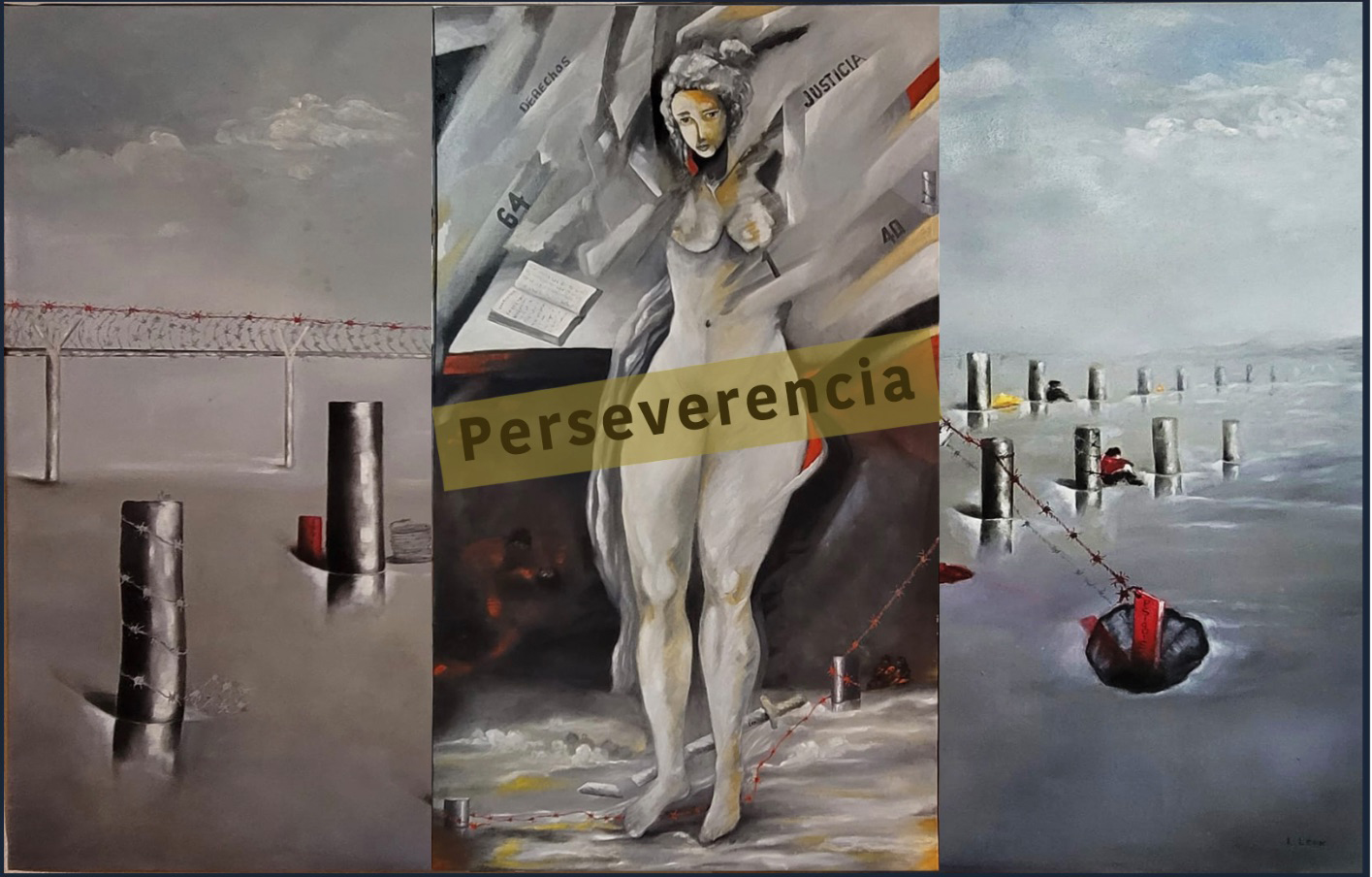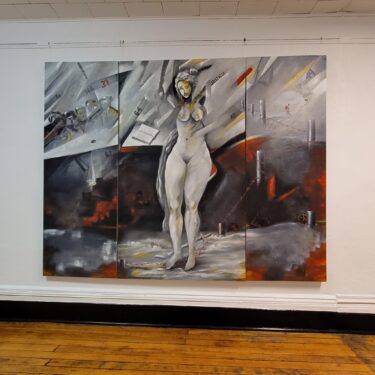
Perseverance
The message we want to send is that despite the obstacles in society and the abuse perpetrated by individuals we can persevere and rebuild ourselves. We are resilient and strong and with the help of our community, family , and organizations devoted to help we can always overcome the many challenges and build a life free from violence.

Arte de Luis De Leon Medina en Colaboración con VIP
La constitución nos da derechos humanos que muchas veces son violados por las mismas autoridades y ciudadanos. Los sobrevivientes de Violencia Doméstica no sólo son víctimas de sus abusadores, sino también de la sociedad y del sistema opresivo en el que vivimos. Las personas son influenciadas por la violencia, los patrones socioculturales y las experiencias de violencia que viven en sus casas.
Las leyes y artículos de la constitución que están númerados representan derechos humanos constitucionales que muestran, que a pesar de las leyes, todavía seguimos siendo víctimas del abuso, opresión y discriminacion. La violencia doméstica es uno de los tantos abusos que tienen que enfrentar las personas / los clientes de VIP. Los derechos humanos redactados en la constitución dominicana son los mismos a los que todos deberíamos tener acceso.
- Artículo 37 Derecho a la vida.
- Artículo 40 Derecho a la libertad de seguridad personal.
- Artículo 49 Derecho a la libertad de expresión e información.
- Artículo 60 Seguridad Social.
- Artículo 62 Derecho al trabajo.
- Artículo 64 Derecho a la cultura.
- Artículo 146 proscripción de la corrupción en los órganos del estado.
Cuando el sistema ofrece poco recursos, la sociedad y los gobiernos son ofensivos y no contamos con la seguridad necesaria, es más difícil escapar de quien causa la violencia. Los sobrevivientes de Violencia Doméstica son personas extremadamente vulnerables y cuando salen de una relación tienen recursos limitados. Nuestra comunidad necesita una sociedad segura que abrace y sostenga a aquellas(os) que están en necesidad y en un estado de indefensión.
La desnudez refleja, entre tantas cosas, la vulnerabilidad, el despojo de los derechos humanos y de la seguridad, la autoestima, el amor propio, la libertad, el apoyo familiar, la integridad, todo aquello que se le quita a alguien a través del abuso y la opresión.
Los senos que amamantan a los niños están mutilados porque la violencia le quita la oportunidad a esas madres responsables de cuidarlos y la oportunidad de darle los recursos para una vida sana. La sociedad necesita también ser amamantada con educación sobre los derechos humanos, el amor al prójimo, el perdón, la aceptación, la empatía, todo eso de lo que carece nuestro mundo. Sólo juntos podemos enfrentar y transformar los patrones culturales para erradicar la violencia y crear una comunidad que proteja no sólo a las mujeres y sobrevivientes de abuso sino también a la sociedad.
The work of Artist Luis De Leon Medina in Collaboration with Violence Intervention Program
The constitution gives us human rights that are often violated by the same authorities and citizens. Survivors of domestic violence are not only victims of their abusers, but also of society and the oppressive system in which we live. People are influenced by the violence, socio-cultural patterns and experiences of violence they live in their homes.
The laws and articles of the constitution that are numbered represent constitutional human rights that show that despite the laws, we are still victims of abuse, oppression and discrimination. Domestic violence is one of the many abuses that people/clients of VIP have to face. The human rights written in the Dominican constitution are the same rights that we should all have access to.
- Article 37 Right to life.
- Article 40 Right to freedom of personal security.
- Article 49 Right to freedom of expression and information.
- Article 60 Social Security.
- Article 62 Right to work.
- Article 64 Right to culture.
- Article 146 Prohibition of corruption in state bodies.
When the system offers few resources, society, and governments are offensive and we do not have the necessary security, it is more difficult to escape from the one who causes the violence. Survivors of domestic violence are extremely vulnerable and when they leave a relationship they have limited resources.
Our community needs a safe society that embraces and supports those who are in need and in a state of helplessness. Nudity reflects, among so many things, vulnerability, the stripping of human rights and safety, self-esteem, self-respect, self-love, freedom, family support, and integrity, all that is taken from someone through abuse and oppression.
The breasts that breastfeed children are mutilated because violence takes away the opportunity for those responsible mothers to care for them and the opportunity to give them the resources for a healthy life. Society also needs to be nurtured with education about human rights, love of neighbor, forgiveness, acceptance, empathy, all that our world lacks. Only together can we confront and transform cultural patterns to eradicate violence and create a community that protects not only women and survivors of abuse but also society.

La violencia doméstica incluye tácticas de abuso que van más allá del abuso físico, como el abuso emocional, verbal y económico entre otros.Los diferentes tipos de abuso impiden que las víctimas puedan liberarse de esas cadenas opresivas que muchas veces son emocionales, y que limitan a las personas el reconocimiento de vivir en una relación abusiva, que es el primer paso para salir de ella. Es importante saber que a veces terminar con una relación no significa que el abuso o el peligro termine en su totalidad. La mayoría de las veces cuando se intenta terminar una relación abusiva es cuando el peligró se intensifica. Pero si él termina la relación es un gran paso a la liberación.
Vemos varias personás sentadas y amarradas así mismo en la epidemia de violencia doméstica está por todas partes y afectá a las personas de todos tipo sociales y culturales y de género. Como en el dibujo vemos que es un camino que pareciera no tener fin y así mismo es la violencia, es un círculo que cuando no tiene la intervención correcta, continua. Seguiremos luchando y creando concienciá para que juntos pongamos fin a la violencia. Queremos ver un futuro donde veamos todos liberados y sin más violencia, pero es un trabajo colectivo en el cual todos debemos de luchar para eliminarlo. Aprendiendo lo que es la violencia intrafamiliar. Debemos de y sentirnos aliados, no juzgando, teniendo empatía y creando concienciá.
Escrito por: Carmen Beltre
Art by Luis De Leon Medina
Edited by Jacqueline Andujar and Carmen Beltre
Domestic Violence includes tactics of abuse that go beyond physical abuse, such as emotional, verbal, and economic abuse among others. The different types of abuse prevent victims from freeing themselves from these oppressive chains that are often emotional and that limit people’s recognition of living in an abusive relationship, which is the first step to leaving the relationship. It is important to know that sometimes ending a relationship does not mean that the abuse or the hazard ends entirely. Most of the time, when you try ending an abusive relationship, the danger escalates, but if you end a relationship, it is a great step to liberation.
We see several people sitting and tied up in the epidemic of violence. Domestic violence is everywhere and affects people of all societies, cultures, and gender. In the drawing, we see that it is a path that does not seem to have an end, and so is violence, it is a circle that, when it does not have the correct, continuous intervention. We will continue to fight and create awareness so that together we can put an end to violence. We want to see a future where we see all liberated and without more violence, but it is a collective work in which we must all fight to delete it. Learning what domestic violence is. we should and feel allies, not judging, having empathy and raising awareness.
Written by: Carmen Beltre
Artwork by Luis De Leon Medina
Edited by Jacqueline Andujar